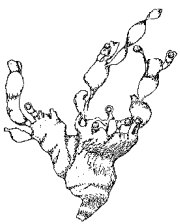 Synonyms: Fucus
brodiaei Turner, 1809; Coccotylus brodiaei in Kutzing,
1869; Phyllophora truncata (Pallas) A. Zin f. brodiaei Turn.
Synonyms: Fucus
brodiaei Turner, 1809; Coccotylus brodiaei in Kutzing,
1869; Phyllophora truncata (Pallas) A. Zin f. brodiaei Turn.Phyllophora brodiaei (Turn J. Ag., 1842)
 Synonyms: Fucus
brodiaei Turner, 1809; Coccotylus brodiaei in Kutzing,
1869; Phyllophora truncata (Pallas) A. Zin f. brodiaei Turn.
Synonyms: Fucus
brodiaei Turner, 1809; Coccotylus brodiaei in Kutzing,
1869; Phyllophora truncata (Pallas) A. Zin f. brodiaei Turn.
Common names: Rom: Filofora; Russ: Fillofora; Turk: Filofora.
Order (Scientific): GIGARTINALES.
Family (Scientific): PHYLLOPHORACEAE.
Taxonomic description: Thallus under brush shape of 5-40 cm, most part of the surface is smooth, the inferior site is cylindrical, the superior site is a thin stem, simple or branched out; on the stem top and branches there are smaller membranous lamella in the feather, oval-feather or heart shape and the superior margins are waved and lobated. The pair of leaflets appear in large numbers, often with the same length as that of the main lamella where the superior margins are branched in lamellas; and the strong detachment of the lamellas give them the shape of fan. On the end of the lamellas is a pair of leaflets and the stem can provide the support for new lamellas-prolification-appearing at the base of the long and short stem. The parts in stem shape of the thallus are sometimes spread in lamellas which in this situation are interspersed on the stem. The central part of the lamella consists of big cells with thicker membranous and which become thinner on the margins; the cortical strata consists of one small cell range, almost square with rounded corners. The reproduction organs are developed on the superior site of the lamellas. Nemathecae with spherical tetraspores until 2 mm diameter. Spermatangia develop at certain ages, under smaller leaves or on the thickened and devious margins of the lamellas; appear under short blades, uncolored, grouped not deeper in the stem and reminiscent of the conceptacles. The matured cristocarps grow in the thallus on the superior margins of the lamellas' spherical bodies. These species do not form carpospores; into the gonimoblast cell blades cleavage of cells takes place.
 IUCN Status:
IUCN Status:
World level:
Black Sea Regional level: VU
Subregion level: VU
Distribution:
Habitats type, Critical habitats, Limiting factors: "Zernov’s field"; on the rocky, and shelly bottoms, at depths ranging between 4 and 47 mm. Present also in the Arctic Ocean, Atlantic littoral of Europe and North America, Morocco, Japan Sea, Mauritius Islands. Species belonging to arctic-northern area. Light penetration.
Biology: Reproduction period between June and November.
Population trends: Severe reduction (together with Phyllophora nervosa and Phyllophora pseudoceranoides); the assessments made in 1971 on the Romanian shelf, on a area of 1,296 km2, found a quantity of 5,976 t, 3,983 t of them on an area of 216 km2, near the Zernov’s field, at a depth of 43-48 m.
Threats: Lowering of light energy penetration, eutrophication.
Conservation measures taken:
Conservation measures proposed: Improve the ecological conditions of the central Northwestern Black Sea.
References:
Compiled by: A.Bologa, A.Bavaru, G.Minicheva.